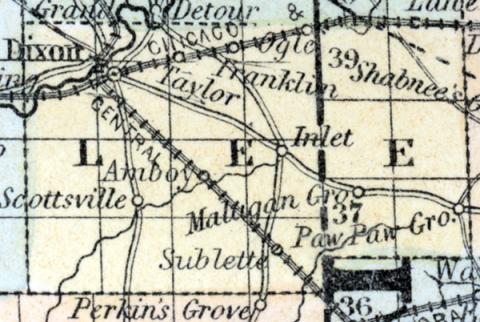DIXON, The county seat of Lee county, is pleasantly situated on the banks of Rock river, where the Illinois Central railroad connects with the Fulton and Iowa Central branch of the Galena road, 98 miles west from Chicago. Until 1830, the whole district around Dixon was in possession of the Winnebago Indians, but in that year, John Dixon, Esq., purchased the land on which Dixon now stands, of Government. In 1837, Dixon was made the county seat, and in 1840 a court house was erected. Though possessing superior advantages, the place seems to have advanced but slowly until the opening of the railroads. In 1845 her population was only 250, and only doubled in the ensuing 4 years. Since that time the increase has been rapid, and the wealth of the city at the present day will compare favorably with that of other cities of the state. The beauty of the surrounding scenery, the healthiness of the climate and the rich agricultural land adjacent, added to the excellent water power, have induced many of the large capitalists to avail themselves of all these advantages from which they have reaped stores of wealth.
On the south bank are two extensive flouring mills, known as the Dixon Mills, and owned by Messrs. C. Godfrey & Sons, and a large foundry and machine shop, belonging to R. P. Robinson, Esq. Within the limits of the city there is also another large steam flour mill, J. & J. Daley proprietors, and the steam foundry of J. Dement & Co., who are also largely engaged in the manufacture of plows. These buildings are built of stone, four and five stories high, and in constant operation. There are also two large saw mills, and a starch factory, besides several smaller manufacturing establishments of various kinds. Dixon is laid out at right angles, her streets even and regular, and ornamented with beautiful shade trees. The general appearance of the city is very prepossessing with its mound like hills and verdant vales, and its fine groves stretching away on almost every side.
Rock river is here spanned by three good bridges, two of which are of wood, the third, over which the railroad crosses, is of more substantial material, having stone abutments and pillars with iron spanners. The river at this point is 800 feet wide with 8 feet fall. Add to the other advantages, that of a direct railway communication east, west, north and south, and Dixon becomes one of the most interesting of our western cities. There are many fine churches and public buildings of note; among the latter is Dixon Collegiate Institute, a splendid brick building, located on an eminence overlooking the town and commanding a view of the river and country about. Its accommodations are sufficient for 860 students, affording them instruction in the higher English brunches and classics.
A weekly paper is published here, called the Republican and Telegraph, under control of Messrs. Shaw & Beckwith, editors and proprietors; and two banking establishments. A large and commodious hall, capable of seating 600 persons, has recently been fitted up for concerts and dramatic entertainments, under the control of S. B. Bancroft, Esq. There are three good hotels, Na-chu-sa, the Mansion and Washington Houses; the first of which is first class. Free carriages run from these hotels to the cars on arrival and departure of trains. Population, 5,500. E. B. Baker, Postmaster. (Hawes' Illinois State Gazetteer...,1859)
Annotations
Latitude
41.844456
Longitude
-89.479044
Railroads
Yes
Type
City or Town
County
Lee
State
Illinois

